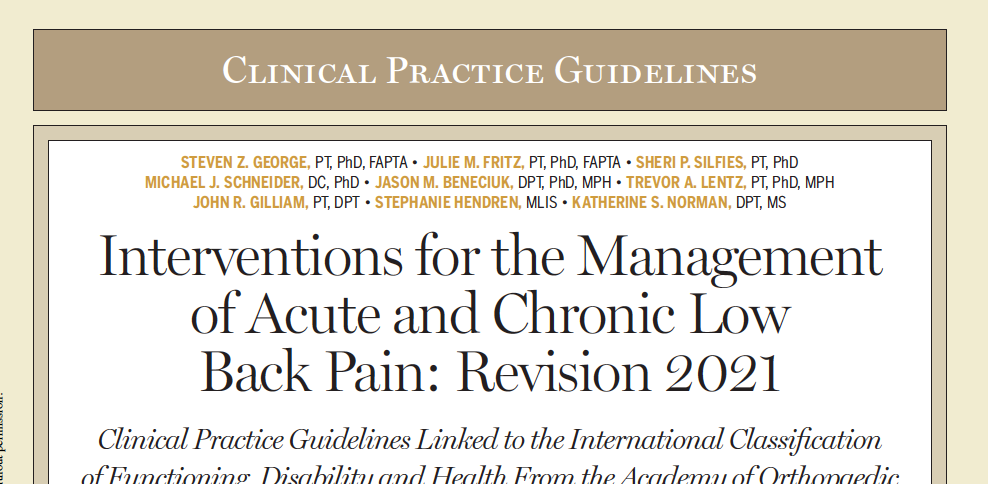🦀 PT Crab Issue 67 - Hot CPGs.

This week we have some hot hot hot drops from JOSPT who pumped out the 2021 revision to “Interventions for the Management of Acute and Chronic Low Back Pain”. Ryan Seacrest is expecting it to be on the Top 40 by the end of the week. If that’s not your jam, we’re also talking how the internet is wrong about your knees. Our King Crab supporters got two more articles this week, one on fear of motion after acute MI (and what to do about it) and another on how to be more reflective as a therapist. Become a supporter here:

Also this week, maybe give PT Crab a drop in your favorite Facebook group? Any shares help us grow and it’s the only way we do, so give it a thought and then a copy and paste. This issue is available online at PTCrab.org/issue-67-blue. Thanks!
Let’s dive in!
The Internet is Wrong About Your Knees
The Gist - We’re all pretty sure the internet can be a great place and that it can be terrible. If you’ve got PFP pain, it’s closer to the terrible side of that scale. PFP pain affects one in four young adults, but 41% of them don’t see a physician for it. Many of them see Dr. Google and his treatment methods are a bit outdated. Researchers evaluated the first two pages of Google and Bing (don’t laugh! Bing gets 500 million visitors per month, jsyk) for the terms knee cap pain and patellofemoral pain and came up with 40 unique URLs to assess. Here’s the roundup:
- 43% didn’t provide sources
- 38% didn’t provide authorship
- 50% didn’t provide funding
- 45% were created to advertise products and services.
- 20% were wrong about what PFP pain was
- 22% recommended knee surgery.
It’s an ugly playing field out there. But good to know about if you’re hitting resistance to your treatments. 22% of people might think they need surgery to treat their PFP pain. Yikes.
Tell Me More - I know that things like authorship and sources seem less important than accuracy (and they are, a little) but they’re essential to helping make sure good information rises to the top. Only 15% of websites gave information about appropriate interventions according to current CPGs. 15%! The information out there was so bad that researchers put sites without information into the good column, since at least they weren’t harmful. That’s what we’re up against. But it’s not unbeatable.
You can do something about it as a PT in a few ways, but one is as simple as finding a PT YouTuber you like and liking / subscribing to their videos. Things like this help them rise up in search, getting more accurate information in front of people. Additionally, the Netherlands recently found that a nationwide, evidence-based health website dropped healthcare usage by 12%. Wow! Lobbying for or working on something like that could be huge. Lastly, the APTA does a lot of this information sharing work and your membership helps pay for it, so consider that when renewal comes around.
Here’s that paper. Right here.
It’s here! It’s here! The New LBP CPGs!
The Gist - JOSPT just dropped the revised “Interventions for the management of acute and chronic low back pain” CPGs and they’re hot hot hot. They’ve made a storm on Twitter and theFacebook and are really in the PT news. I’m not going to go into all of them here because you really should look at them yourself (they are open access, like all CPGs even though the APTA pretends to paywall them, jsyk) and print the first few pages until you’re totally in touch with the recommendations. I will grab a few bits from the summary just to show you the heat we’re dealing with here.
Exercise for Acute Low Back Pain
C Grade - Physical therapists can use exercise training interventions, including specific trunk muscle activation, for patients with acute low back pain (LBP).
Exercise for Chronic Low Back Pain
A Grade - Physical therapists should use exercise training interventions, including trunk muscle strengthening and endurance, multimodal exercise interventions, specific trunk muscle activation exercise, aerobic exercise, aquatic exercise, and general exercise, for patients with chronic LBP.
B Grade - Physical therapists may provide movement control exercise or trunk mobility exercise for patients with chronic LBP.
Manual and Other Directed Therapies for Acute Low Back Pain
A Grade - Physical therapists should use thrust or nonthrust joint mobilization to reduce pain and disability in patients with acute LBP.
And on and on. The CPGs get into education strategies, classification systems, other manual therapies, and more. Definitely give them a look-see if just to complain about them. Any little helps!
The full PDF download is available here: Grab the hottest hit of the Fall right here.
And that’s our week! Definitely check out the CPGs, especially if you need something new to rant on twitter about. They’re definitely the “in” thing. Also, if you know a good website for teaching about PFP, lmk! I’d love to share it with our readership. As ever, please do consider becoming a supporter (here) and do please share PT Crab with colleagues. You guys are how we grow.
Bye!
